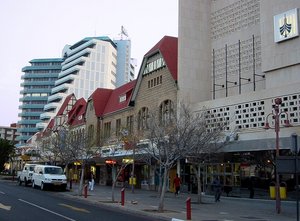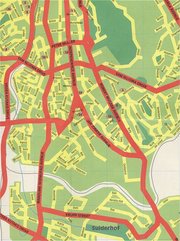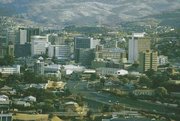Windhoek
|
|
Windhoek, Namibia
| Area | 645 km² (400 mi²) | |
|---|---|---|
| Established | 18 October 1890 | |
| Population | 230,000 | |
| Population Density | 356.6/km² (575/mi²) | |
| Administrative Division | Khomas | |
| Mayor | Matthew Shikongo | |
| Time Zone | South African Standard Time: UTC+1 | |
| Latitude and Longitude | Latitude: 22.56°S | Longitude: 17.09°E |
Windhoek, population 230,000, is the capital of Namibia. It is a major trade centre of sheep skins. Windhoek was originally the centre of a Nama chief, who defeated the Herero inhabitants of the region in the 19th century. Germany occupied the region in 1885, and it became the seat of colonial rule in 1892, as the capital of the colony of South-West Africa. During World War I, Windhoek was captured by South African troops.
| Contents |
History
The city of Windhoek is traditionally known by two names: Ai-Gams, from the Nama people, which literally refers to the hot springs that were once part of Windhoek, while the second name, Otjomuise, meaning a place of steam, was given by the Herero people. Both traditional names reference the hot springs.
The early settlements of Windhoek came about because of the water from the hot springs. In the mid-1800's Captain Jan Jonker Afrikaner settled near one of the main hot springs, located in the present-day Klein-Windhoek, an upper-class suburb of Windhoek.
Theories vary on how Ai-Gams/Otjomuise got its modern name of Windhoek. Most believe the name Windhoek is derived from the Afrikaans word Wind-Hoek, meaning "corner of wind." It is also thought that the Afrikaners named Windhoek after the Windhoek Mountains, at Tulbagh in South Africa, where the early Afrikaners settlers had lived. In those days Windhoek was the point of contact between the warring Namas, led by Jan Jonker Afrikaner, and the Herero.
In Windhoek, Afrikaners built a stone church that held 500 people, which was also used as a school. Two Rhenish missionaries, Hugo Hahn and Heinrich Kleinschmidt, started working there in the 1840s and were later succeeded by two Wesleyans. Gardens were laid out and for a while Windhoek prospered, but wars between the Nama and Herero eventually destroying the town. After a long absence, Hahn visited Windhoek again in 1873 and was dismayed to see that nothing remained of the town's former prosperity. In June 1885, a Swiss botanist found only jackals and starving guinea fowl amongst neglected fruit trees.
Kirche_denkmal_nam.jpg
In 1878, Britain annexed Walvis Bay and incorporated it into the Cape of Good Hope in 1884, but Britain was not interested in extending its influence into the interior of Africa. A Request by merchants from Luderitzbucht resulted in the declaration of a German protectorate over German West Africa in 1884. The German colony came into being with the determination of its borders in 1890 and Germany sent a protective corps, called the Schutztruppe under Major Curt von Francois, to maintain order. Von Francois stationed his garrison at Windhoek, which was strategically situated as a buffer between the Nama and Herero, while the twelve strong springs provided water for the cultivation of food.
Present-day Windhoek was founded on 18 October 1890, when Von Francois lay the foundation stone of the fort, which is now known as the Alte Feste (Old Fortress). During the next fourteen years Windhoek developed slowly, with only the most essential government and private buildings being erected. In Klein-Windhoek, plots were allocated to settlers, who started farming on a small scale with fruit, tobacco and dairy cattle.
After 1907, development accelerated as people migrated from within country to the city and also some emigrated from outside the country. There was also a larger influx of western settlers arriving from Germany and South Africa. Businesses were erected on Kaiser Street, present Independence Avenue, and along the dominant mountain ridge over the city, including the three eye-catching castles.
The German colonial era came to an end during World War I when South African troops occupied Windhoek in May 1915 on behalf of Britain. For the next five years, a military government administered Namibia. Development of Windhoek and Namibia in general came to a standstill. After World War II Windhoek's development gradually gained momentum, as more money became available to improve economic climate. After 1955, large public projects were undertaken, such as the building of new schools and hospitals, the tarring of the town's roads (started in 1928), and the building of dams and pipelines to finally stabilize the water supply.
With Namibia's independence from the former South African Colonial Apartheid Regime in 1990, the city experienced a new wind of change that led to accelerated growth and development. Windhoek became the seat of a first democratically elected government of the Republic of Namibia, headed by the head of state the president, Sam Nujoma. Windhoek is twinned with Trossingen, Germany.
Transportation in the city
In 1928, Kaiser Street, now Independence Avenue, was the first paved road in Windhoek. Ten years later the next one, Gobabis road, now Sam Nujoma Drive, was also paved. Today most of Windhoek's total road network of over 500 kilometres is tarred.
Windhoek's three main access roads from Rehoboth, Gobabis, and Okahandja are paved, and are designed to be able to withstand the largest possible flood to be expected in fifty years. The roads are designed to carry traffic moving at 120 km/h and should last for 20 years.
Windhoek has two airports: Eros on its outskirts for smaller craft, and Windhoek International Airport 42 km east of the city. A number of foreign airlines operate to and from Windhoek. Air charters and helicopter and fixed-wing aircraft rentals are also available.
Windhoek is also served by bus public transportation routes throughout the city.
Windhoek International Airport (WDH)
Windhoek International Airport, situated 45 kilometres outside Windhoek, handles well over 400,000 passengers a year. The airport is Namibia's only international airport, and has one runway without capacity limitations. It directly connects bi-weekly to each of the following airports: London (Heathrow), Frankfurt, and Munich. Southern Africa's hub, Johannesburg, is only a two-hour flight away, from where it is possible to connect to over 50 cities. South African Airways, LTU, and Air Namibia all have daily flights to Windhoek International Airport, whilst TAAG Angolan Airlines has bi-weekly turnarounds to Luanda.
Eros Airport
Eros is the busiest airport in Namibia in terms of take offs and landings. This city airport handles around 12,000 individual flights a year, the majority of which are light aircraft. Primarily, limitations such as runway length, noise, and air space congestion have kept Eros from developing into a larger airport. Most of Namibia's charter operators have Eros as their base.
Climate
Windhoek is situated in a semi-desert climatic region. Days are mostly warm with very hot days during the summer months, while nights are generally cool.
The winter months of June, July and August usually experience the most rainful. Minimum temperature range between 5°C (41°F) to 18°C (64°F). Nights are usually cold although the temperature seldom drops below zero, and it almost never snows.
The country experiences a drought more or less once every decade.de:Windhuk es:Windhoek fr:Windhoek io:Windhoek id:Windhoek he:וינדהוק nl:Windhoek pl:Windhuk pt:Windhoek ro:Windhoek ru:Виндхук fi:Windhoek sr:Виндхук sv:Windhoek



